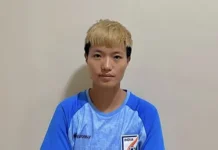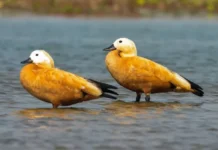[ Likha Tatam ]
Let us retrospect how, when and why Nyokum was organised at Joram village before and after coming into a mass agricultural and cultural festival of Nyishi community in the year 1967.
We are told that Nyokum was organised in the villages of Joram in Lower Subansiri district (now Kiyi Panior district) from time immemorial for our good health and bumper produces of the agriculture crops, mainly wet rice cultivation, which was and is till now a staple food of the Nyishi community, particularly of Joram area.
Nyokum was usually organized as Nyokum Uii Panam, which the people of Joram called Nyokum Nyoin Henam. The word ‘Nyokum’ consists of ‘Nyok’ and ‘Kum’, which means ‘Land’ and ‘Gather together’. Initially, Joram village consisted of a cluster of villages such as Pekir (Phu), Peil, Migo and Sekh. For the purpose of Nyokum Uii, these villages were divided into two group – Pekir (Phu) and Peil – as one group and Migo and Sekh as other group. Nyokum was organised on rotation basis among these groups in every succeeding year, usually in the last part of June, or in the first part of July, a few days after completion of paddy seedling transplantation in the WRC fields and at the beginning of their germination.
Nyokum Uii Panam is usually organised through chicken liver examination to determine the mode and host of celebration. After chicken liver examination, Nyokum Uii Panam is conducted at a selected house as host. The nyub (priest) with bu (the priest’s assistant) chant Nyokum Nyoin hymns lyrically to appease the benevolent uii (spirit) by offering a number of chicken and animal with a belief to be blessed in return with good health and proper growth of paddy seeds to have a bumper harvest, so that people could live peace and prosperous for one agricultural season.
The priest and his assistant, along with the members of the host house and a select group of people of various ages as diir sonbo dance along the way and visit each and every house of the village in order to drive away the Diir Uii and women sweep behind them also throw away all the unused things from their houses with a belief that these things are the poor spirit which leads the family of that house to live the life of poverty.
The people of each and every house follow behind the nyub, the bu, and diir sonbo with male members carry khomey in their hands and female members carry iggin on their back, packed with food (rice) and drinks (oppo). The crowd gradually increases from every visited household and becomes a huge procession when they reach to the altar called Nyokum Nyugu, which is usually installed at a high place of the village as venue called Nyokum Putu on the second day.
On the third day, early in the morning, all the male members of various age groups of the host village gather at the Nyokum Putu and proceed for Dapo Poyenum in order to install prohibition post in few selected junction points to restrict the entry of strangers or outsiders into the village and exit from the village for few days till Tvjwr Panam day.
After Dapo ponam works, the Dapo members go to the villages of other groups where food (rice), drinks (oppo) and meat (vdwn) are lavishly served called ajwn honam. Each family has their own chosen friend for the day called Nyokum ajwn, who have to generally reciprocate the next year as exactly or more hospitality in return.
The fourth, fifty and sixth days are rest days or prohibited days as no outsider are allowed to enter and no villagers are allowed to exit or do any kind of physical work outside the house or any work that produces loud sound which could disturb the nature.
On the sixth day evening the priest comes to host’s house and chants Tvjwr Pahnam, and on the next day, or the seventh day, the nyub comes to the venue, Nyokum Putu, along with bunch of Tvjwr and a pot of water. The nyub places the required Tvjwr on the Nyokum Nyugu and pour Tvjwr Wss (Tvjwr Water) and then distributes rest of the Tvjwr and water to needy wet rice cultivation (WRC) owner.
The WRC owner receives the Tvjwr and Iss and goes to their respective WRC field and places Tvjwr as well as pours Tvjwr water at the northern end or at the main irrigation source of that field, so that any unwanted things that destroy the paddy could be protected and damaged crops could be healed. That way the Nyokum Ui Panam activities end for the year and people expect bumper harvest.
We are also told time and again that during the Dapo prohibition, many outsiders were detained or attacked physically and imposed huge pecuniary punishments by the villagers as and when one enter into the prohibited area on the prohibition day even innocently or unknowingly. These incidences make other people and the governments curiosity about Nyokum Uii Panam, which finally compelled the government to recognise the Nyokum Panam that led to organised first modern or central Nyokum in 1967 in Joram village and adopted Nyokum as the festival of Nyishi community and there onward, Nyokum has become the common festival which spreads to other Nyishi inhabited areas.
The few intellectuals of the community start pondering on the significance of Nyokum festival and interpret the meaning and mode of Nyokum celebration, based on the presumably assumed mythology told by our forefathers and adopt in consensus.
Let us also see why the Nyokum Uii Panam was organised in those days in the village. During these days there was no proper access of modern amenities like road, school, hospitals, agricultural and allied activities. People were solely dependent on agriculture and allied produce for their daily living, and practiced the indigenous way of cultivation, for which most of the time people lived with starvation due to insufficient produces from unscientific cultivation. During that period, the people were totally illiterate and innocent and they were completely dependent on nature and worshipped natural objects and offered sacrifice of birds and animals in order to appease the natural spiritsm, so that nature would be pleased and bless them abundantly in return for healthy and wealthy living.
And let us also discussed how contemporary Nyokum is celebrated. Obviously, with the advent of education and the modern improved new technology in the villages, people are no longer dependent on natural spirit for bumper harvest but rather use new farming technology and high-yielding varieties of seeds that produced agricultural products more than required similarly depend on medical facilities for healthy living.
Nowadays, Nyokum is organised nominally just to showcase the traditional costumes of the community and to keep the identity alive for the future generation on 24 and 26 February every year, which might have been shifted the Nyokum celebration to pre-cultivation season.
In this way, many people organise symbolic Nyokum in the form of advance Nyokum or pre-Nyokum in many metropolitan cities of the country as well as in universities, colleges, offices, individual household, etc, by offering traditionally produced gifts, food and drinks to the guests where mythology or the genesis of Nyokum are read out.
All the members of the community usually wear traditional attire of various forms and designs during Nyokum celebration. These forms of celebration have no involvement of nyub (priest), no birds or animals sacrifices, no installation of altars (nyugu), no lyrical chanting or prayer of any form are done, but only merrymaking, greeting, dance drama performance, games and sports activities, Nyokum history telling in chronological and community feasting. However, formal imitation of past are done sometimes, and most of the modern Nyokum in the villages are also organised without any acts of ritual, etc, but instead games and sports activities and cultural shows are organised and guests are invited from outside. There is no prohibition as used to be practiced in the original form of Nyokum.
After the increases of intellectuals in the community, many are striving to go back to the original form of Nyokum to keep the olden identity alive, and also endeavour to interpret the meaning of Nyokum in a more refined way and try to claim absolute guardianship of the Nyokum behest of indigenous patriotism and persevere to prevent the modern form of thinking and living in the community. As a result, many have made it as a means of living. Today, the differences of opinions among the faith group developed on the mode of celebration of Nyokum and try to take it to the line of religion by suffixed new word Yullo, which was not in original form of Nyokum or in the initial years of celebration of modern Nyokum with a notion to preserve the community identity alive.
For me, the word Nyokum actually should be Nyiokum, which is derived from two words ‘Nyi’ and ‘Okum’, meaning ‘people’ and ‘come together’, respectively, which means people coming together in a particular place to celebrate Nyokum in traditional attire with dance drama performance and community feast.
At last but not the least, I opine that if academicians, intellectuals, CBOs, religious leaders of various faith group of the community such as the NFC (Nyishi Festival Committee), the CNC (Central Nyokum Committee) and the NIIS (Nyishi Indigenous Identity Society), the NIFCS (Nyishi Indigenous Faith and Cultural Society), the NACS (Nyisi Art & Culture Society), the NBCC (Nyisi Baptist Church Council), etc, sitting together to draw a agreeable common Nyokum festival code for the best interest of the community in order to keep alive the cultural identity and to maintain the cordial atmosphere among the community members, keeping in mind that no more appeasement lyrical chanting, animal sacrifices, etc, required for bumper harvest of the crops to natural spirits specially on advent of the education, know-how of farming.
The above narration is based on my personal experiences and opinion as a native of Joram village where Nyokum was originated also expressed based on my regular observations and participations of Nyokum celebrations in different areas since 1980 to till date, as well as from the information or opinion expressed by the various people through social media and hence, expressions and opinions are of my own which has nothing to do with any others and binding. Error, omission and exaggeration if any are regretted. (The contributor can be reached at likha.tatam@rediffmail.com.)






